Take
a 10-year time warp with us (1987 through 1997), by
reading our in-depth feature on the Final Fantasy
series (through Final Fantasy VII).
Developed
by Squaresoft, the Final Fantasy series is quite possible
the greatest RPG series ever to be made. This feature
currently covers the first seven games, but we will
be adding the newer games as they become retro.

Remember
that time when you spent a
whole day trying to get a gold Chocobo?
Those were good times, eh?!
Final Fantasy

Back
in 1987, there was a small software company called
Square. At that time it was known for a nifty arcade
game called Rad Racer, which had been a hit on Nintendo's
cutting-edge NES console. Then the company
released its first role-playi
 The
familiar fight screen.
The
familiar fight screen. |
|
 Ouch!
That's gotta burn...
Ouch!
That's gotta burn... |
The boffins at Square had packed an entire world on
a 2Mb NES cartridge. Players were transported to a
mystical land where the powers of the four elements
were bound and controlled by four crystal orbs. However,
the orbs were fading and an evil darkness was spreading
across the globe. Vicious pirates ruled the seas,
evil creatures crept through the shadows and demons
stirred in the depths of the earth. The ancient prophecy
of Lukahn was coming to pass, and only the coming
of the four heroes he foretold, known as the light
warriors, could save the world from the evil forces.
When the mysterious Garland kidnapped the daughter
of the King of Coneria, the dream city, four warriors
were summoned to his court. Each young hero held a
strange orb they had owned since childhood.
Although primitive by today's standards, at the time
of it's release Final Fantasy was a revelation. The
graphics were stunning, the music incredible and it
was awesome to play. Resplendent with a richly-detailed
plot, a clever game system, a vast gaming world, and
hundreds of monsters, spells, weapons, armors and
other special items, Final Fantasy was a big hit in
Japan.
The
game system was different to the subsequent Final
Fantasy titles. Rather than having fixed characters,
the players chose from six classes- Fighter, Thief,
Black Belt or White, Red and Black mages-to create
a party of four heroes. However, many other elements
of the game made it to FFVII.
It
took three years for Final Fantasy to make it to the
U.S., but eventually it appeared in 1990 and enjoyed
significant, if not incredible, success. Square had
no idea what they had started.
Final
Fantasy II
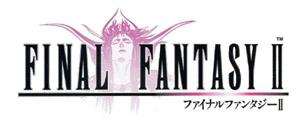
After
the critical success and acclaim of Final Fantasy,
it seemed inevitable that a sequel would appear. Final
Fantasy II arrived in 1988. In what was to become
the norm for Final Fantasy games, though, FFII wasn't
a sequel in the normal sense of the word. Rather,
it was a unique game in it's own right, linked to
its predecessor by common elements in the game system
and gameworld.
Another
2Mb SNES cartridge, Final Fantasy II was a story of
rebellion against a dark, oppresive ruling power,
foreshadowing the themes of Final Fantasy VI and VII.
The power-hungry Emperor of the Paramekian Empire
had turned to dark magic to summon evil monsters in
his bid to rule the world. The Kingdom of Phin struggled
against these hordes, but was eventully overrun. In
the aftermath of Phin's defeat, four warriors are
trying to escape the carnage when they are attacked
by Imperial Horsemen and cut down. Saved from death
by the healer Minh, three of the companions find themselves
caught up in the rebellion been organised by Princess
Hilda of Phin.
Graphically
and musically similar to Final Fantasy, FFII boasted
an even more complex and intriguing plot, together
with a similarly huge range of weapons, armour, spells,
monsters and all the other bits and peices that have
since come to be expected from a Final Fantasy game.
Although not as much of a shock to Japanese gamers--
Final Fantasy, after all, had demonstrated Square's
enviable talent for designing role-playing games--
it was another hit.
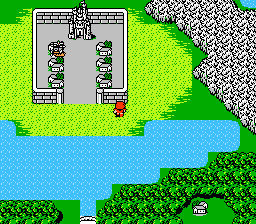 "I've
had enough fighting for one day... Hope this
town is safe!"
"I've
had enough fighting for one day... Hope this
town is safe!"
|
|
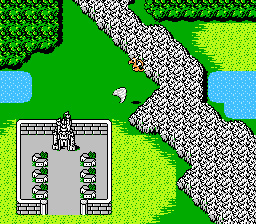 Looks
like we're in for bad weather
Looks
like we're in for bad weather |
The
most significant change from Final Fantasy was that
there were no character classes or experience levels.
Instead, the characters improved in various areas
by doing things connected to them--hitting monsters
with a sword gained fighting abilities, for example,
while taking lots of damage in a fight lead to increases
in hit points.
FFII
put you in charge of a group of four characters, like
before, but this time there were three fixed heroes
(Frionel, Maria and Guy), all tied into the plot.
There was one slot for an extra member, which was
filled by different characters as the game progressed--a
concept used in most of the following Final Fantasy
games.
In
addition to sharing many spells, weapons and monsters
with it's predecessor, Final Fantasy II introduced
new ones to the series. Chocobos made their first
appearence, as did the huge sea monster, Leviathan.
As with the dragon Bahamut in Final Fantasy, though,
Leviathan was present as an actual monster-- one that
had a habit of eating your ship-- rather than as a
summon spell. Likewise, Bombs and Behemoths made their
debut in FFII. In addition to introducing some of
the spells that have since become regular features
of Final Fantasy games--including Ultima, Meteor,
Toad and Mini--this was also the first game in the
series to introduce the Magic Points system for casting
spells. FFII was only released in Japan and was a
massive hit like Final Fantasy.
Final
Fantasy III
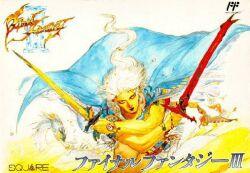
It
was another two years before the third Final Fantasy
game arrived, and by this time it was one of the most
eagerly anticipated releases of it's time. Final Fantasy
III, released in Japan in 1990, was the last game
in the series to appear on the NES, which was beginning
to look a little dated in the face's of a new wave
16-Bit consoles. Nonetheless, it was another excellent
title, and very well received among fans.
The
nearest thing to a true sequel in the Final Fantasy
series, FFIII shared many elements with of the original
game. The plot concerned an ancient evil, long-contained
but now seeking to escape it's bonds and lay waste
to the world. Once more, only the four Light Warriors
of legend could defeat this dark force and restore
balance to the world. The game began with four young
orphans exploring a mysterious cave. Once inside,
they are attacked by beasts, and forced to fight through.
Eventually, in a crystalline chamber, they discover
the lost Wind Crystal, which explains the danger facing
the world. Proclaiming them to be the chosen ones,
the Crystal grants each of the four a special power,
and sends them out on a quest to find and destroy
the malignant power threatening their world.
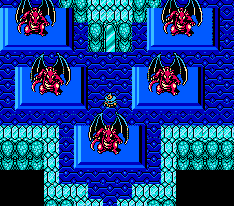 Gargoyles
everywhere
Gargoyles
everywhere |
|
|
FFIII was a 4Mb NES cartridge, and Square put the
extra capacity to great use. As well as pushing the
humble NES to it's graphical and sonic limits, the
third Final Fantasy game was also far more complex
and detailed. The system was similar to that in the
original, allowing players to choose the names and
character classes for the four main heroes. But this
time there were more classes on offer, and the game
featured more locations, monsters, weapons, equipment
and spells.
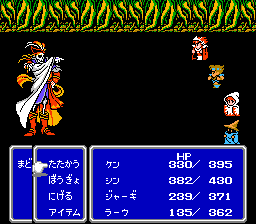
As
usual, your characters are tiny
compared to the monsters you must fight.
Amongst
the new features were several new additions that have
since become trademarks of the Final Fantasy line.
Chocobos were back, and this time there were two different
times. The cutesey Moogles also made their first appearance,
together with several more monsters and weapons that
are now standard features. FFIII also introduced several
new classes, including Dragoon and the Caller, together
with a new set of summoning spells. Although their
names were different these spells are still recognizable
as the same ones that appeared in FFVII--Chocobo,
Shiva, Ramuh, Ifrit and the rest. Despite it's impressive
sales in Japan, Final Fantasy III never appeared outside
it's home country.
Final
Fantasy IV

By
1991, Square had gone from being just another small
games company to one of the most respected software
houses in Japan. The Final Fantasy series had already
become one of the most popular game lines in the country,
and the release of the original Final Fantasy in America
in the previous year had begun to pave the way for
the international fame that was to follow.
Perhaps
the most important step the company ever made though
(at least until the release of FFVII on the Playstation)
was with Final Fantasy VI.
The
fourth game in the series was the first RPG to be
released on Nintendo's new console, the Super Famicon
(or SNES as we know it). A 16-bit machine with an
impressive array of custom graphics and sound chips,
the SNES was an impressive piece of kit at the time,
and the Japanese gaming world was eager to see what
Square could do with the machine's greater power.
They certainly weren't disappointed.
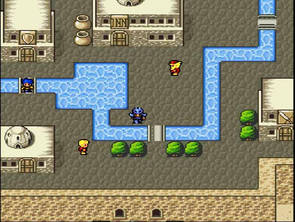 Graphics
improved greatly for the
Graphics
improved greatly for the
first SNES Final Fantasy game. |
|
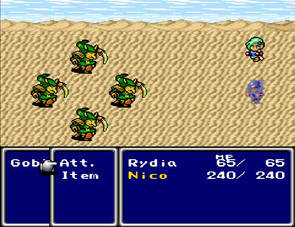
Even
the battle screen
backgrounds improved.
|
FFIV
was an 8Mb cartridge, and put the vastly more impressive
sound and graphics of the SNES to good use. The characters
and monsters were larger, more colourful and much
more detailed than before, the look of the game's
magic was improved, and the summon spells were awesome.
The
extra capacity of the SNES cartridge, and the machine's
greater processing speed and memory, were put to great
use to provide gamers with one of the most complex
and imaginative storylines ever to appear in a videogame.
FFVII
returned to the fixed character concept first used
by Square in FFII, casting the player as Cecil, a
Dark Knight and captain of the Red Wings, an elite
force of military airships in the Kingdom of Baron.
As the game began, though, Cecil questioned the desire
of his King to capture the Elemental Crystals, and
was sent to deliver a strange package to a nearby
town. When the package exploded, destroying the town
and nearly killing him, Cecil and his friend Kain
vowed to fight against the King's power-mad ambitions.
As the pair made their way through the game, they
befriended nine other characters.
After it's massive success in Japan it was unsurprising
that FFIV was translated into English and released
in America, where it enjoyed more healthy success
and critical acclaim. However, due to the fact that
FFII and FFIII had not been released in the States,
it was renamed FFII, beginning a confusing number
policy that was only stopped when Square released
Final Fantasy VII, as, well, Final Fantasy VII.
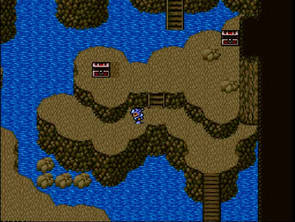 The
8Mb cartridge capacity allowed
The
8Mb cartridge capacity allowed
Square to make a much larger game
than they were able to on regular
NES hardware. |
|

Building
interiors
became more elaborate
|
There
were two versions of FFIV released in Japan-the standard
game, and FFIV Easytype. This Easytype edition was
intended for younger players, and had many items,
monsters, spells and skills removed. It was also the
version on which the American FFII was based, so there's
never been an English language edition of the complete
FFIV.
Final
Fantasy V
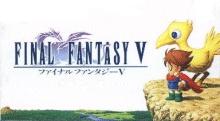
Eighteen
months after unveiling FFIV, and irrevocably changing
what Japanese gamers expected from a console RPG,
Square was back again with a new chapter in the series.
With it's seemingly unbeatable track record, some
people were beginning to wonder if Square could maintain
the same level of quality and imagination. As Final
Fantasy V proved, the answer was yes.
Probably
the darkest of the FF games to date, FFV was set in
a world where the elemental Crystals which protect
it from evil were breaking, and all hope seemed lost.
The story began with the king of Tycoon, sensing something
wrong, travelling to the shrine of the Wind Crystal.
Only when he arrived, the Crystal shattered into a
million pieces, and the wind died.
That,
however, was only the start of the problems. FFV featured
one of the most unpleasant villains ever to appear
in a FF game-both devious and insane-and the result
was a very downbeat story, with major characters getting
killed throughout the game, the world exploding, and
more. As the unfortunately named Butz, the hero of
the story, it was up to the player to try to sort
everything out across no less than three worlds.
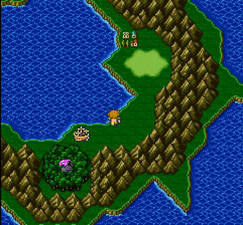
This 16Mb game was even
more beautiful than its predecessor. |
|
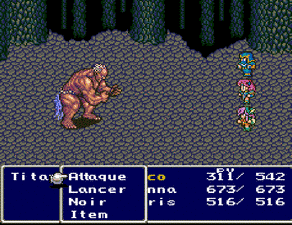
Battle screen
|
With
FFV, Square upped the ante and filled up a 16Mb SNES
cartridge with one of the best Final Fantasy games
to date. The main link between this and the previous
titles was the Final Fantasy name and many common
elements in the gameworld. FFV combined many elements
from the systems used in the previous releases, and
added a few unique twists of it's own. Once more,
the player controlled a party of four characters with
fixed identities tied into the background story and
plot .
This
time, though, instead of each character having a fixed
class, they could be switched around, allowing players
to create a customized party. As the players moved
throughout the game, they discovered special crystals
containing the souls of dead heroes, each of which
allowed access to new character classes-over 20 in
all. At any time outside of combat, each character
could be changed from one class to another, learning
more skills and abilities from them. By mastering
different classes, elements from each could be combined
to form unique mixes of abilities.
This
clever game system was a major pull for RPG fans,
with the inevitable result that Square had another
hit on it's hands. Sadly, though, FFV was never translated
into English, and no US version was ever released.
Final
Fantasy VI

Another
18 months later, the Final Fantasy series returned
for what was to be it's last outing on the SNES. The
scences upon it's release in Japan in 1994 were almost
as chaotic as those three years later, when FFVII
finally arrived , and for many long-term fans of the
series, Final Fantasy VI remains their favorite so
far.
One
of the first 24Mb SNES cartridges, FFVI was a huge
success in Japan. Square squeezed every last ounce
of performance out of the machine, pushing it's graphics
and sound to the limit. All the special effects that
the SNES could manage were packed in, along with some
of the best music ever to grace the machine.
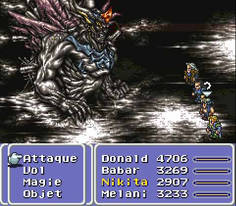
SNES graphics and sound were pushed to the limit
for FFVI. |
|

Environments
became much larger with the 24Mb cartridge
capacity.
|
Complete
with the most tortuous and involved plot in the series
so far, FFVI was also the first to introduce the blend
of magic and technology to the series that was used
again to great effect in FFVII, and looks to be a
central aspect of FFVIII. The game takes place in
a world that was almost destroyed a thousand years
previously, when evil powers created magical beings
called Espers and pitted them against each other.
Now a new civilisation has arisen, one based on technology
and science, where magic is just an evil legend. As
the game began, though, the rulers of the Empire had
heard rumours of an Esper encased in ice, and sent
some soldiers to investigate. When they found the
Esper, a strange glow surrounded them, killing all
but a woman called Terra. When she awoke, she discovered
that the Empire had been controlling her thoughts,
and that magic is once again been reported...
This
was just the beginning of a story of epic proportions,
which encompassed around 75 hours of gameplay. FFVI
dropped the innovative class changing system for a
simplified version similar to that used in FFVII,
and instead concentrated on the narrative, atmosphere
and multiple plot threads. Some hardcore players accused
it of being too easy, but even they had to agree that
it was a stunning achievement.

Character and monster animations improved greatly. |
|
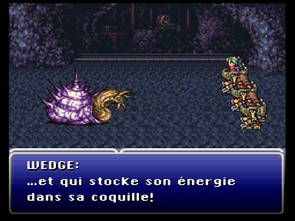
What kind of a monster is that?!
|
FFVI
was released in the US to greater success than was
expected. For the second time, it was decided to stick
to the different numbering system, and the US version
was called FFIII.
Final
Fantasy VII
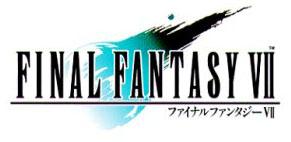
It
was three years in the making, and the subject of
more rumors, speculation and gossip than any previous
game in Japan, but Square finally returned to it's
most popular and successful series with Final Fantasy
VII. A large part of the delay was due to changing
formats-Square felt it had done as much as it could
with SNES, and wanted to start developing for one
of the next generation consoles. Of course, given
the company's long-standing association with Nintendo,
everyone expected them to plump for the N64.
Square, however, decided that the only way to create
the kind of games it wanted was to use the massive
storage space of CD-ROM, and once it became clear
that Nintendo's wonder machine was going to stick
to the cartridge format, the company looked for another
platform. In one of the most significant endorsements
of Sony's games machine ever, Square announced that
Final Fantasy VII would be released on the Playstation.
 Battle
scenes were fully 3D in FF7.
Battle
scenes were fully 3D in FF7. |
|
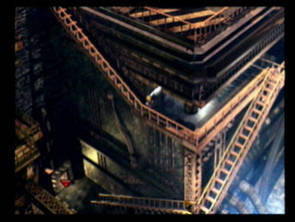
Most
of the backgrounds (except the world map)
were beautifully pre-rendered and very detailed.
|
This,
of course, is the game that we all know and love.
Cloud Strife's struggle with the evil schemes of the
oppressive Shinra Corporation and his own mysterious
past is a simply astonishing achievement, and both
it's techno-magical world and main characters have
become icons for the PlayStation, rivaling such stars
as Lara Croft for the limelight. Still probably the
most stunning game available for Sony's little grey
box of tricks, all three CD's of FFVII are packed
to the gills with sumptuous graphics, intricate plotting
and ridiculously addictive gameplay.
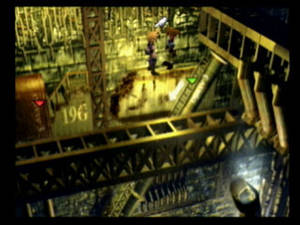
The
game's lighting effects were superb.
PSX was definitely pushed to its limits with this
game.
Even
given the Playstation's 32-bit architecture and much-famed
3D capabilities, no-one ever expected an RPG to look
this good. If you still have not got a copy, you really
should slap yourself around the head for being a fool
and rush down to your local store and get one- just
be prepared to give up at least a couple of months
of your free time.
A BIG thanks to Digital
Fan for donating this article!
